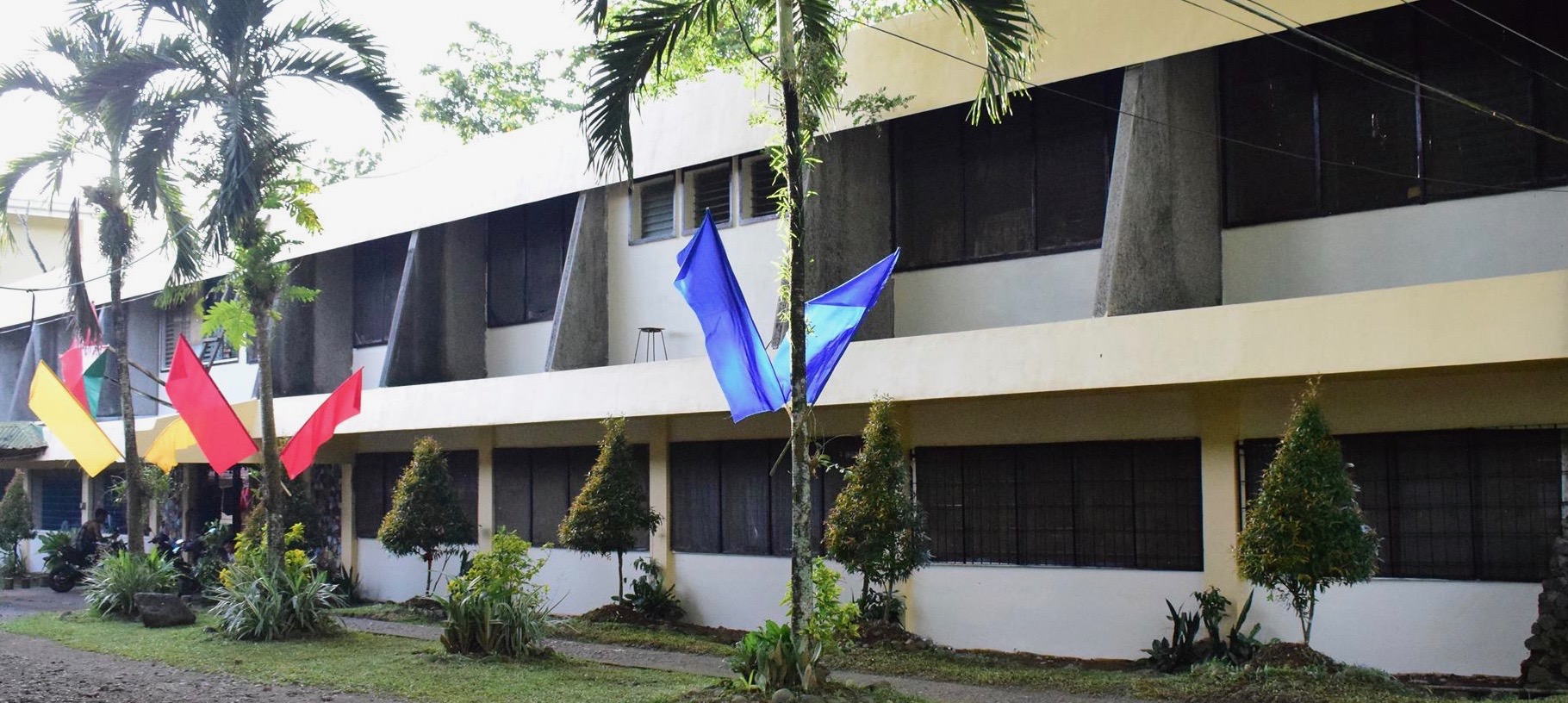Content (main)
- Details
- Written by Visayas State University
-
Published: 24 February 2020
Here at VSU, we aim to provide quality service to our students by engaging them in an active learning environment centered on their success. This is one with our goal to produce highly competent, quality and world-class manpower in science and technology, especially in agriculture, environmental management and industry who are proficient in communication skills, critical thinking, and analytical abilities.
Attributes of a VSU Graduate
-
- Competence
- Graduates possess relevant knowledge, skills, and attitudes needed in their chosen fields, and can apply these in the practice of their profession and in giving service to the community.
-
- Resilience and Endurance
- Graduates are flexible, adaptable, and steadfast when facing challenging life situations.
-
- Critical Thinking Skills
- Graduates are reflective and can critically analyze and evaluate facts, observations, and differing opinions to arrive at a sound judgment or conclusion.
-
- Effective Communication Skills
- Graduates can communicate information and ideas effectively and express needs and opinions clearly to varied audiences.
-
- Leadership Skills
- Graduates act professionally, and ethically, and can assume effective leadership roles in their chosen careers and in society.

• College Admission Test
Become a full-pledged Viscan and take the VSUCAT. Check the examination schedule and requirements here.
• Scholarship
Find the right grant that suits your needs.

• Student Services Office
The University Student Services Office (USSO) is ready to assist you with our welfare and development services/programs tailored to meet your student needs.
• Student Housing
Choose where to spend your college days while on campus. Stay near Mt. Pangasugan or by the Camotes Sea.

• Supreme Student Council
Know your leaders and college representatives.
• Student Media Organization
The Amaranth is the official student media organization of the Visayas State University. Currently, hailed as the best student publication in Region 8.
• Accredited Organizations
Involve in extra-curricular activities by joining an organization spanning from course-related, religious, greek-lettered, to interest groups.
• Sports, Recreation, and Arts
Join our varsity team (Team Phytons) or participate in our culture and arts activities and bring pride to the university.
• Student Bulletin
Be in the loop with university happenings and updates.
• Events
Mark your calendars. Here's what to expect for the rest of the year.
- Details
- Written by Visayas State University
-
Published: 17 February 2020
Got what it takes to be a full-fledged #ProudViscan?
Read more ...- Details
- Written by Visayas State University
-
Published: 14 January 2020
 Plant-parasitic nematodes are pests of agricultural crops and cause crop yield reduce when the roots are damaged. Pineapple is extremely sensitive to root feeding nematodes. Four genera of plant parasitic nematodes were found to be associated with Queen pineapple such as Rotylenchulus reniformis, Pratylenchus brachyurus, Xiphinema sp. and Helicotylenchus sp. as soil samples were collected and isolated.
Plant-parasitic nematodes are pests of agricultural crops and cause crop yield reduce when the roots are damaged. Pineapple is extremely sensitive to root feeding nematodes. Four genera of plant parasitic nematodes were found to be associated with Queen pineapple such as Rotylenchulus reniformis, Pratylenchus brachyurus, Xiphinema sp. and Helicotylenchus sp. as soil samples were collected and isolated.
- Details
- Written by Visayas State University
-
Published: 14 January 2020
 In Region VIII, Queen Pineapple populations including the newly established ones were documented as to size and location. As surveyed, Queen pineapples are grown in Baybay City, Javier, Kananga, Ormoc City and Villaba in Leyte, Sta. Rita in Samar and Silago in Southern Leyte, with a total area of 229.78 hectares.
In Region VIII, Queen Pineapple populations including the newly established ones were documented as to size and location. As surveyed, Queen pineapples are grown in Baybay City, Javier, Kananga, Ormoc City and Villaba in Leyte, Sta. Rita in Samar and Silago in Southern Leyte, with a total area of 229.78 hectares.

In Luzon, Queen Pineapple is mainly grown in the Provinces of Camarines Norte. A total of 2,525 hectares of the province is planted to pineapple translated to 82% of total pineapple area in Municipality of Basud, Labo, San Lorenzo Ruiz and San Vicente, Camarines Norte.
- Details
- Written by Visayas State University
-
Published: 14 January 2020

Figure 1. A) Queen pineapple with Heart rot disease and B) Phytophthora cinnamomi under a microscope (100x)
A. Heart rot and root rot
• Causal Organism: Phytophthora cinnamomi
• Symptoms: soft rotting of the basal white tissues of the youngest leaves at the heart of the apical meristem; necrosis (Green and Nelson, 2015; Ceniza et al, 2018)
• Economic Importance: most destructive soil-borne pathogen with 20-30% prevalence (Shen et al., 2013)
• Distribution: As surveyed, it was observed in Ormoc City, Leyte and Silago, Southern Leyte
a. Management Options: Integration of regulatory, cultural, chemical, and biological practices (Green and Nelson, 2015); Use of antagonists Trichoderma and Penicillium sp. (Oclarit, 2018)

Figure 2. A) Queen pineapple leaves with anthracnose disease, B) Colletotrichum gloeosporioides under microscope (100x)
B. Anthracnose
• Causal Organism: Colletotrichum gloeosporioides
• Symptoms: dark, water-soaked lesions on leaves (Kumar, 2014; Ceniza et al, 2018)
• Economic importance: wide host range: coconut, mango, banana, avocado, papaya, etc. (Nelson 2008)
• Distribution: As surveyed, it was observed in Baybay City, Javier, Leyte, and Silago, Southern Leyte
a. Management Options: Carry out regular weeding and timely pruning of the infected plant parts; Plant resistant varieties (Waller, 1992); use of wood vinegar (Torres, 2018); use of plant extracts (Payot, 2018)
 Figure 3. A) Queen pineapple leaves with leaf blotch, B) Pestalotia sp. under a microscope (100x)
Figure 3. A) Queen pineapple leaves with leaf blotch, B) Pestalotia sp. under a microscope (100x)
C. Leaf Blotch
• Causal Organism: Pestalotia
• Symptoms: chlorotic, water-soaked flecksthat enlarge to become dry, yellow, then red-brown, blocky to oval lesions (IPCM, 2013; Alegre et al, 2018)
• Economic Importance: Affects photosynthesis of the plant (Alegre et al, 2018)
• Distribution: It was observed pineapple fields in the Municipality of Basud and San Vicente, Camarines Norte (Alegre et al, 2018)
a. Management Options: Crop rotation, proper crop debris management, and fungicide treatments (IPCM, 2013)

Figure 4. A) Queen Pineapple with blight disease; B) Fusarium sp. under microscope (400x)
D. QP Blight
• Causal Organism: Fusarium
• Symptoms: Drying of leaves, noticeable loss of vigor and severe injury to the vascular level (Alegre et al, 2018)
• Economic Importance: Death of plants (Alegre et al, 2018)
• Distribution: It was observed in San Lorenzo Ruiz, San Vicente, Basud, Bibirao and Calasgasan, Camarines Norte (Alegre et al, 2018)
a. Management Options: Crop rotation, proper crop debris management, and fungicide treatments (IPCM, 2013)
 Figure 5. A) Queen pineapple with leaf spot; B) Curvularia sp. under a microscope (100x)
Figure 5. A) Queen pineapple with leaf spot; B) Curvularia sp. under a microscope (100x)
E. QP Leaf Spot
• Causal Organism: Curvularia
• Symptoms: Yellow, brown lesions which eventually turns dark on QP leaves (Alegre et al, 2018)
• Economic Importance: Affects photosynthesis of the plant if severe could result to death of plant (Alegre et al, 2018)
• Distribution: It was observed in San Lorenzo Ruiz, San Vicente, Basud, Bibirao and Calasgasan, Camarines Norte (Alegre et al, 2018)
a. Management Options: Crop rotation, proper crop debris management, and fungicide treatments (IPCM, 2013)
- Details
- Written by Visayas State University
-
Published: 14 January 2020
1. Use of Potential Antagonists
• Trichoderma sp. (fig.1)
• Penicillum sp. (Isolate1) (fig.2)
• Penicillum sp. (Isolate2) (fig.3)

2. Use of Plant Extracts/Plant-Based Solution
Plant extracts that inhibits the germination of spores of Colletotrichum sp. were:
• Mayana, Coleus scutellarioides (fig.4)
• Panyawan, Tinospora rumphii (fig.5)
• Tigbaw, Callicarpa cana (fig.6)
• Asyang, Mikania cordata (fig.7)
• Ginger, Zingiber officinale (fig.8)
• Bio-Path (fig.9)

3. Use of Wood Vinegar
Wood vinegar is a liquid generated from the gas and combustion of fresh wood burning in airless conditions.
Effective wood vinegar plant sources found to affect the development of Colletotrichum sp at 7% (fig.10) and 10%(fig.11) concentration were:
• Tigbaw, Callicarpa cana
• Bamboo, Bambusa vulgaris

- Details
- Written by Visayas State University
-
Published: 14 January 2020

Figure 1. Queen Pineapple fruit infested with PPMB
Description
- Pink pineapple mealybug, Dysmicoccus brevipes Cockerell (PPMB), is one of the major pests of pineapple [Ananas comosus (L.) Merrill].
- Belongs to Family Pseudococcidae and described as cottony, small, oval and soft-bodied sucking insect (Joy, et al., 2013).
- Feeds on the fruits, roots, stem, and leaves of the plant (Ceniza et al, 2018)
- Dispersed by ants (Joy et, 2013) because PPMB secreteS sweet and sticky liquid called honeydew as a by-product of its feeding (Rohrbach and Johnson, 2003).
- Distribution: Baybay City, Javier, Ormoc City, Villaba in Leyte; Silago in Southern Leyte; San Lorenzo in Camarines Norte (QP Project 4)
- Details
- Written by Visayas State University
-
Published: 14 January 2020

Figure 1. H. pseudococcina parasitizing on adult PPMB
1. Parasitoids
Encyrtid Parasitoid, Hambletonia pseudococcina (Compere)
Order: Hymenoptera
Family: Encyrtidae
Description: A very small parasitoid with clubbed-like antennae that can be parasitized up to 8 adult PPMBs
Figure 2. A) Nymphal and (B) adult stages of predatory earwig
2. Predators
- Predatory black earwig, Chelisoches morio
Order: Dermaptera
Family: Chelisochidae
Description: Has four nymphal instars that can reach up to 120 days prior from hatching to mortality and can consume 1-2 adult PPMB and up to 100 individuals of PPMB crawlers per day
Figure 3. Cryptolaemus montrouzieri feeding on adult PPMB
- Predatory coccinellid beetle, Cryptolaemus montrouzieri
Order: Coleoptera
Family: Coccinellidae
Description: A voracious predator with a long history in biological control against mealybugs that could potentially consume up to 20 individuals of PPMB crawlers and 1 PPMB adult per day.
3. Entomopathogenic Fungi (EPF)
EPFs are microorganisms that specifically infect and often kills insects and other arthropods. EPFs are eco-friendly and good substitute for chemicals
Three (3) isolates of EPFs against PPMB:
• Metarrhizium anisopliae (fig.4)
• Lecanicillum lecanii (fig.5)
• Beauveria bassiana (fig.6)

4. Botanical Insecticides
Botanical insecticides are naturally occurring chemicals extracted from plants or minerals to control or minimize insect pest population.
Botanical insecticides against PPMB includes:
• Jatropa curcas (fig.13)
• Murraya koenigii (fig.14)
• Spagneticola trilobata (fig.15)
- Details
- Written by Mark Quevedo
-
Published: 11 March 2019
College of Agriculture and Food Science
Department of Agricultural Education and Extension
Department of Development Communication
Department of Food Science and Technology
Department of Plant Breeding and Genetics
College of Arts and Sciences
Department of Biological Sciences
Department of Arts,Languages and Literature
Department of Philosophy and Social Sciences
Department of Pure & Applied Chemistry
College of Education
Department of Teacher Education
College of Engineering
Department of Agricultural Engineering
College of Forestry and Environmental Sciences
Institute for Tropical Ecology and Environmental Management
College of Management and Economics
Department of Business Management
Institute of Strategic Research and Development Studies


